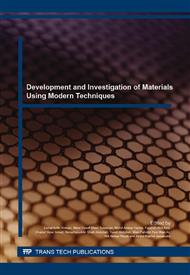[1]
Y. Prambudia, M. Nakano, Exploring Malaysia's transformation to net oil importer and oil import dependence, J. Energies 5 (2002) 2989–3018.
DOI: 10.3390/en5082989
Google Scholar
[2]
G.K. Kumar, S.H.K. Reddy, S.N. Ahmed, Application of cellular manufacturing concepts in an automobile workshop, Int. J. Eng. Res. Appl. 2 (2012) 1616–1619.
Google Scholar
[3]
I. Changa, C. Chungb, S. Hanb, Treatment of oily wastewater by ultrafiltration and ozone, J. Desalin. 133 (2001) 225–232.
Google Scholar
[4]
Z. László, K. László, T. Zita, S. Sándor, B. Cecília, Treatment of model oily astewater by microfiltration, J. Chem. Eng. 57 (2012) 21–24.
Google Scholar
[5]
D. Mazumber, S. Mukherjee, Treatment of automobile service station wastewater by coagulation and activated sludge process, Int. J. Environ. Sci. Dev. 2 (2011) 64–69.
DOI: 10.7763/ijesd.2011.v2.98
Google Scholar
[6]
M. Bujang, N.A. Ibrahim, Physicochemical quality of oily wastewater from automotive workshop in Kota Bharu, Kelantan Malaysia, J. Basic Appl. Sci. 6 (2012) 748–752.
Google Scholar
[7]
S.E. Agarry, O.O. Ogunleye, Box-Behnken design application to study enhanced bioremediation of soil artificially contaminated with spent engine oil using biostimulation strategy, Int. J. Energy Environ. Enginnering 3 (2012) 31.
DOI: 10.1186/2251-6832-3-31
Google Scholar
[8]
K.V. Darsa, A.J. Thatheyus, D. Ramya, Biodegradation of petroleum compound using the bacterium Bacillus Subtilis, Sci. Int. 2 (2014) 20–25.
DOI: 10.17311/sciintl.2014.20.25
Google Scholar
[9]
S.A.M. Mohammed, I. Faisal, M.M. Alwan, Oily wastewater treatment using expanded beds of activated carbon and zeolite, J. Chem. Pet. Eng. 12 (2011) 13.
Google Scholar
[10]
T.J. Mohammed, M. Hashim, E.H.Z. Al-abideen, Treatment of Oily Wastewater, J. Eng. Technol., 25 (2005) 407 – 427.
Google Scholar
[11]
H. Farajnezhad, P. Gharbani, Coaggulation treatment of wastewater in petroleum industry using poly aluminium chlorine and ferric chloride, Int. J. Res. Rev. Appl. Sci., 13 (2012) 306–310.
Google Scholar
[13]
J. Kong, Q. Yue, B. Wang, L. Huang, B. Gao, Y. Wang, Q. Li, Preparation and characterization of activated carbon from leather waste microwave-induced pyrophosphoric acid activation, J. Anal. Appl. Pyrolysis, 104 (2013) 710–713.
DOI: 10.1016/j.jaap.2013.05.024
Google Scholar


